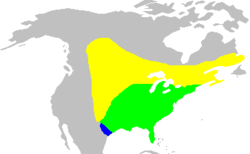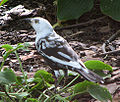- Common Grackle
-
Common Grackle 
Conservation status Scientific classification Kingdom: Animalia Phylum: Chordata Class: Aves Order: Passeriformes Family: Icteridae Genus: Quiscalus Species: Q. quiscula Binomial name Quiscalus quiscula
(Linnaeus, 1758)Approximate range in North America.
Yellow = summer only
Blue = wintering only
Green = all yearThe Common Grackle, Quiscalus quiscula, is a large icterid.
Contents
Description
The 32 cm (13 in) long adult has a long dark bill, pale yellowish eyes and a long tail; its feathers appear black with purple, green or blue iridescence on the head, and primarily bronze shine in the body plumage. The adult female is smaller and usually less iridescent; her tail in particular is shorter, and unlike the males, does not keel in flight and is brown with no purple or blue gloss. The juvenile is brown with dark brown eyes.
Distribution and habitat
The breeding habitat is open and semi-open areas across North America east of the Rocky Mountains. The nest is a well-concealed cup in dense trees (particularly pine) or shrubs, usually near water; sometimes, the Common Grackle will nest in cavities or in man-made structures. It often nests in colonies, some being quite large. Bird houses are also a suitable nesting site. There are 4-7 eggs.
This bird is a permanent resident in much of its range. Northern birds migrate in flocks to the southeastern United States.
Ecology and behavior
The common grackle forages on the ground, in shallow water or in shrubs; it will steal food from other birds. It is omnivorous, eating insects, minnows, frogs, eggs, berries, seeds, grain and even small birds and mice. Grackles at outdoors eating areas often wait eagerly until someone drops some food. They will rush forward and try to grab it, often snatching food out of the beak of another bird. Grackles prefer to eat from the ground at birdfeeders, making scattered seed an excellent choice of food for them. In shopping centers, grackles can be regularly seen foraging for bugs, especially after a lawn trimming.
Along with some other species of grackles, the common grackle is known to practice "anting," rubbing insects on its feathers to apply liquids such as formic acid secreted by the insects.
This bird's song is particularly harsh, especially when these birds, in a flock, are calling. Songs vary from, year round "Chewink Chewink" to a more complex breeding season "Ooo whew,whew,whew,whew,whew" call that gets faster and faster and ends with a loud "Crewhewwhew!" The grackle can also mimic the sounds of other birds or even humans, though not as precisely as the mockingbird, which is known to share its habitat in the Southeastern United States.
In the breeding season, males tip their heads back and fluff up feathers to display and keep other males away. This same behavior is used as a defensive posture to attempt to intimidate predators. Male common grackles are less aggressive toward one another, and more cooperative and social, than the larger boat-tailed grackle species.
Grackles tend to congregate in large groups, popularly referred to as a plague. This enables them to detect birds invading their territory, and predators, which are mobbed en masse to deter the intruders.
Relationship with humans
The range of this bird expanded west as forests were cleared. In some areas, it is now considered a pest by farmers because of their large numbers and fondness for grain. Despite a currently robust population, a recent study by the National Audubon Society of data from the Christmas Bird Count indicated that populations had declined by 61% to a population of 73 million from historic highs of over 190 million birds.[1]
Unlike many birds, the grackle benefits from the expansion of human populations due to its resourceful and opportunistic nature. The common grackle population has greatly increased in the Austin, Texas, area in recent years and is regarded as nuisance by some, due to aggressive behavior.[2] Common grackles are considered a serious threat to crops by some, and notoriously difficult to exterminate and usually require the use of hawks or similar large birds of prey.[3][4]
Photo gallery
References
- BirdLife International (2004). Quiscalus quiscula. 2006. IUCN Red List of Threatened Species. IUCN 2006. www.iucnredlist.org. Retrieved on 12 May 2006. Database entry includes justification for why this species is of least concern
External links
- Common Grackle videos, photos & sounds on the Internet Bird Collection
- Common Grackle Information and Photos - South Dakota Birds and Birding
- Common Grackle Species Account - Cornell Lab of Ornithology
- Audubon's Common Birds in Decline Report
- Common Grackle Bird Sound
Categories:- IUCN Red List least concern species
- Quiscalus
- Birds of the United States
- Birds of Canada
Wikimedia Foundation. 2010.







